Please view these information tabs to help with determining the proper Mechanical Clock Pendulums for your clock.
Sequential steps to obtain a pendulum
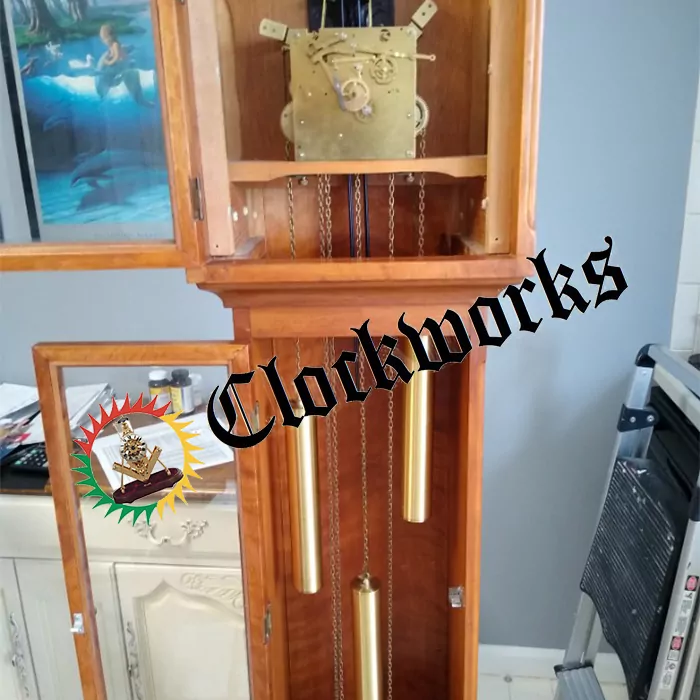
- 1. First, know who really made the movement. If the clock was made in Germany post WW2, it will be one of four makers. Hermle, Jauch, Kieninger, or Urgos.
If none of these names are on the movement it is still, most likely made by one of these factories. They made movements for other clock makers who had their own name on the movement because they were buying so many.
Best to use the identification page to narrow down exactly who made the clock movement. Then return to this page to continue the process of pendulum measuring on German Clocks.
- 2. Get the CM numbers, or PL numbers from the back plate of the movement itself. Match these numbers with what we are offering.
- 3. Determine the bob diameter. Measure how wide the inside of the case is and then subtract 4 inches. This will be the maximum pendulum bob diameter that the clock case can handle.
- 4. Decide between Lyre, Wood stick, or a brass rod pendulum if the options are there. They all come with a brass round bob for the end, but leading down to the bob can be any of these three styles.
- 5. Order it
- 6. Once received, the pendulum install it on the clock, then Put The Clock In Beat.
Pendulum Measuring on German Clocks
Measure the pendulum on a German Clock from the very top of the movement down to the very bottom of the pendulum rating nut threads.
Naturally, if the clock says something like 94cm, choose 94cm from the list, making sure it also lists the correct bob diameter. Clockworks will calculate the length, making sure it is correct, before shipping it.
A customer may receive the pendulum and think that it is not the correct length. Most likely, this is not the situation. Ordering a pendulum for a Hermle 94cm movement, does not mean a 94cm long pendulum will arrive. The pendulum may be shorter, although it will be correct.
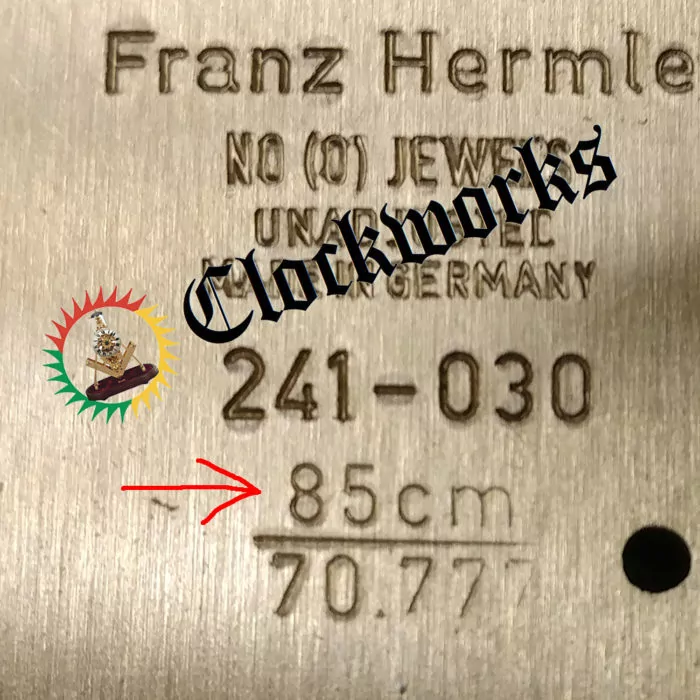
Determine Bob Diameter after Pendulum Measuring on German Clocks
Of course, bob diameters vary so that they will not hit the sides of the case. bob width is determined by the inside of the case width.
Measure how wide the inside of the clock case is and then subtract 4 inches from that measurement. That measurement is the largest diameter Bob that can be used in the clock case. Likewise, a smaller diameter bob can be used, but not a larger one.
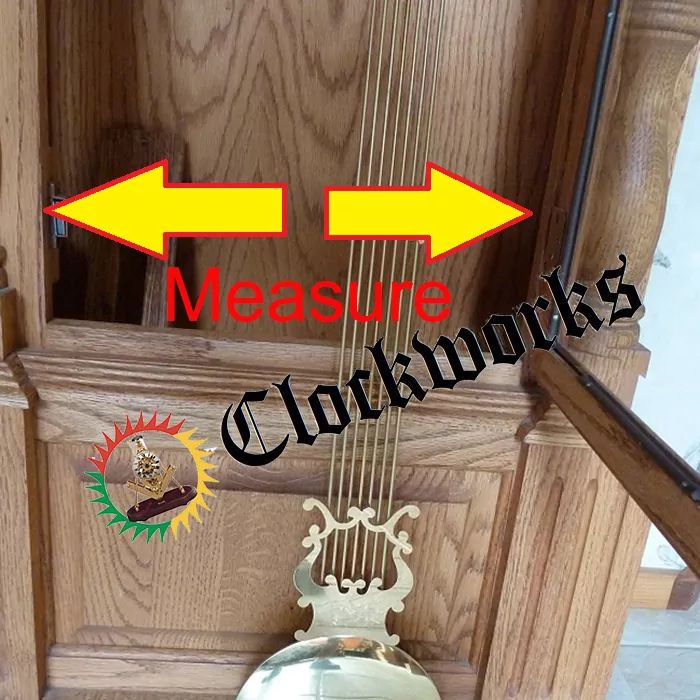
Pendulum clocks need to be put "In Beat"
Finally, after installing the new clock pendulum the clock will need an adjustment for it to run correctly. This is very easy to do and only takes a few minutes. Moreover, no mechanical pendulum clock will run right without "Putting The Clock In Beat" first.
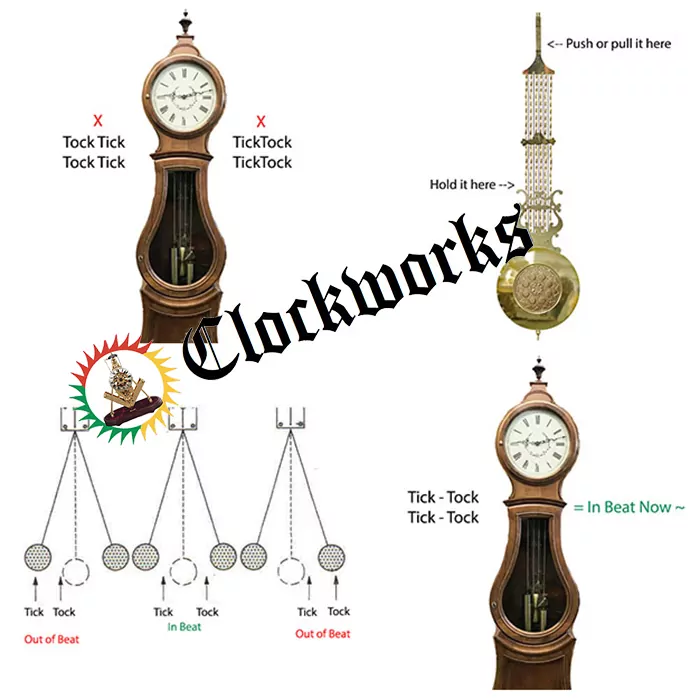
Types of Clock Pendulums
There are three basic categories for types of clock pendulums. These are lyres, wood sticks and brass rods. Mantle clocks have very short pendulums which use a mantle bob. This section will not discuss these types of pendulums. Instead, search the keywords mantle bob if working with a mantle clock.
This will bring up the correct product for mantle clocks. What is in this section is the types of clock pendulums available for shelf, wall and floor clocks. Each of them have their own pros and cons. We can make recommendations on what was typical for a particular clock. Ultimately, it comes down to personal preference.
- Brass rod style pendulum for small shelf or wall clocks.
- Metal Lyre style pendulums for floor clocks.
- Wood stick pendulums are for almost everything.
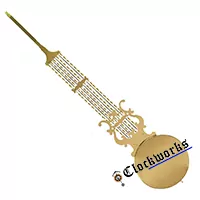
Metal Lyre
A Metal Lyre pendulum is a type of clock pendulum that is most decorative of pendulums. A floor clock can mean a grandfather, grandmother, or granddaughter clock. Basically, any clock that sits on the floor versus a wall or mantle. These types of clock pendulums are for post WW2 German movements.
This would be Urgos, Kieninger, Jauch and Hermle units.
These are the only post WW2 German units made. Generally speaking, the stamp may have another name on the backplate of the movement. This is due to companies paying a premium to have their name put on the movement. However, this does not change who the actual manufacturer is. In short, the ones who made the movement are one of the German companies already on the above list.
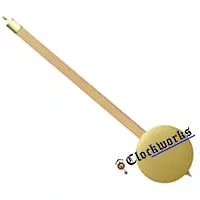
Wood Stick
The wood stick type of clock pendulum is sent with no stain on it. This is so the stick can have the same stain to match the clock case. Likewise, a black stick looks nice with the gold bob as well. Certainly, by leaving it plain the customer can customize the stick to whatever color they deem fit.
A wood stick type of clock pendulum consists of the stick, the top hook, the rating assembly and the round bob. They are capable of accepting any size bob and can easily be cut if too long. Because of these qualities, they are the most versatile pendulums out of the three.
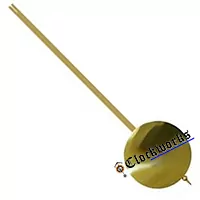
Brass Rod
Shelf clocks or wall clocks mainly use brass rod types of clock pendulums. It is not common for them to be on granddaughter or grandmother clocks. It is possible but not likely. These pendulums tend to cost more for a couple of reasons.
First, they are made of brass. Of course this is a much more expensive medium than the wood. Second, they are custom cut to size by us here at Clockworks. We will cut it to the exact length needed for the specific clock movement upon ordering. Getting the correct CM length is very important to ensure the brass rod is the right length.
Types of Clock Pendulums In Summary
As shown above, the three styles of pendulums have their own good points and drawbacks. For the most part, wood stick types of clock pendulums tend to be the most versatile. They can have stain, or paint, in any color. Moreover, modifications are fairly easy.
After that, the brass rod would be the next flexible type. They are custom cut to the correct length prior to being sent. Lastly, the lyre pendulum is the most decorative out of the three styles. Modifications to these pendulums are minimal.
Please feel free to contact us if there are any questions on any of these types of clock pendulums. As always, we are here to help. When contacting us, make sure to have the movement number that is on the backplate of the movement itself. This is the only way to know who made the movement. Without this information it is not possible to direct you to which pendulums would be correct. As always, pictures of the movement are always helpful.
Grandfather Clock Pendulum Information
Grandfather clock pendulum information begins with the obvious discussion of length. The length of the pendulum on German units comes in a few CM options.
German units measure the pendulum from the top of the movement to the bottom of the nut threads.
The pendulum itself, the leader it hangs on, and the suspension spring that the leader hangs on.
All three components in centimeters make up that CM length in the drop down menu.

Pendulum length information
To know how long the actual pendulum is, subtract 15CM from the options with the pendulum length.
This will exclude the leader and suspension spring, and be the actual pendulum length from tip to tip off of the clock.
This length can vary as if a larger pendulum bob is selected, the actual length of the pendulum gets longer.
Why the CM length matters at all is because if the pendulum length is not near the CM length of the movement, the clock will not keep time.
So the gearing in the movement and the pendulum length works together to keep time around the specified CM length.
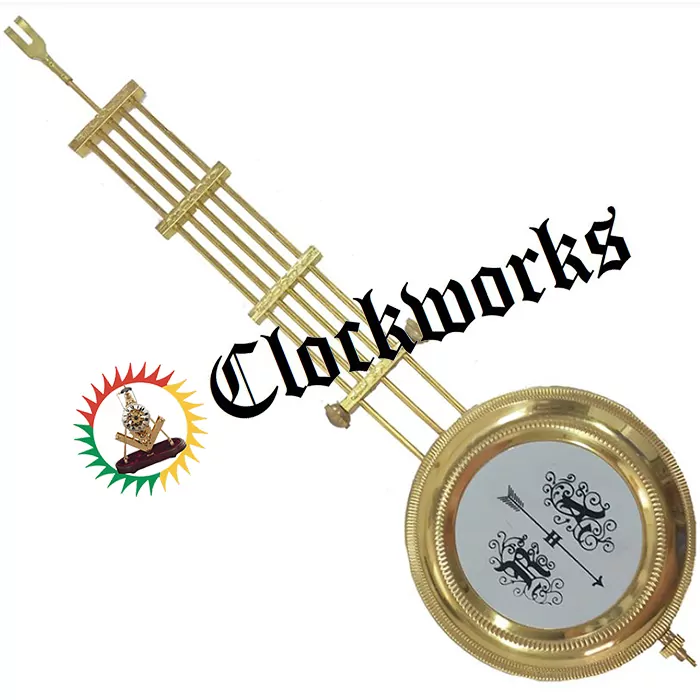
The bob width Options
A Lyre grandfather clock pendulum comes with either a 6 1/2, 8 1/2, or 10 1/2 inch bob diameters. The 'Bob' is the round disk at the bottom of the pendulum.
Moreover, the CM length on the movement will indicate the length of the pendulum from the TOP of the movement all the way down to the bottom of the pendulum nut threads.
This is an approximate length that depends on other factors such as bob diameter and weight of the pendulum.
Basically if the CM is 94CM the pendulum itself will be about 35 inches tip to tip off of the clock, and the 114CM option would put this same measurement at approximately 44 inches.
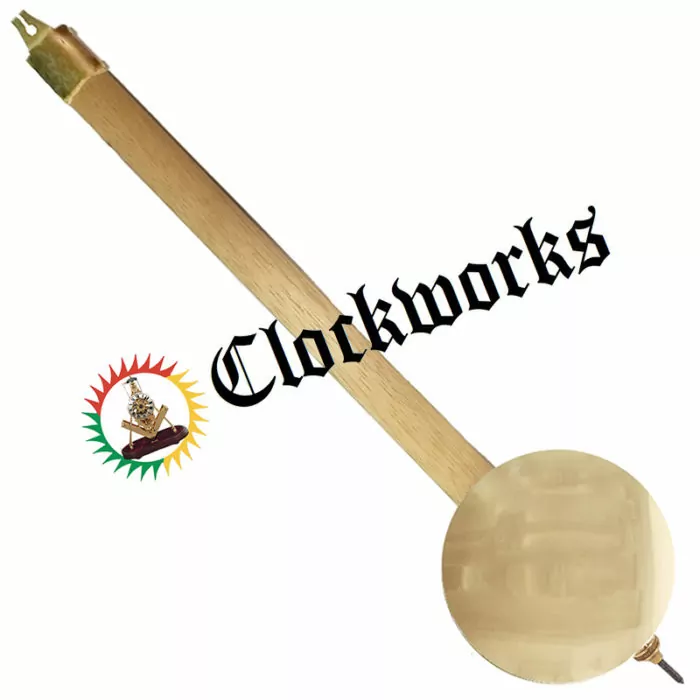
The Mechanical Clock Pendulum Assembly
The mechanical clock pendulum assembly does not mean just the pendulum alone.
The use of the word assembly means the pendulum consists of three components and not just the pendulum. A pendulum assembly consists of the suspension spring at the top, the leader that hangs on it, and then the pendulum.
Pendulum styles
Usually mechanical clock pendulum makers are not movement makers and the two are married together by a person or place. A place such as Clockworks or Howard Miller instead of the movement manufacturer. This is interesting because it explains why there can be so many variations in pendulums for one movement.
The pendulum could be a brass rod, wood stick, or metal lyre style.
Pendulum bob diameter size
To determine the bob diameter for a mechanical clock pendulum, need to consider what looks good as well as which one won't whack the sides of the case. A good rule for the bob diameter is it needs two inches on each side to swing.
So if the clock case is 12 inches wide the bob cannot be more than 10 inches. In this example we would need a 10 inch bob but these are not made.
So the choice is clear that for a 12 inch wide clock case the maximum bob size to get is 8 1/2 inches wide. If this rule did not exist and the 10 inch wide bob is run the clock may go tick, knock, tock, knock, as it hits the sides every time it swings. Eventually the clock will stop running from this resistance. Plus it is quite annoying to hear that sound!
Pendulum lengths for Mechanical Clock Pendulum Assembly
The length of the pendulum has to be correct for the gearing inside the movement. If the mechanical clock pendulum is too long the clock will be too slow. If the pendulum is too short the clock will run too fast. When a clock is too fast or slow it usually has nothing to do with the movement itself. It only has to do with the pendulum length alone and nothing else.
Pendulum top mount hook
The top hook has to hook to the leader on the movement. The leader is the part that holds the mechanical clock pendulum up in the air and it hooks to the suspension spring. Sometimes an old pendulum will not hook to the new movement the same way as it did on the old unit. However, this is not common. It may or may not need a new top hook for the pendulum.
Pendulum leader
The leader is the 3 to 7 inch long part that the mechanical clock pendulum hangs onto. The leader hangs onto the suspension spring which is on top of the movement. At the same time it will have the crutch on the back of the movement engaged with the center of the leader. The crutch is the wig wag part that is sticking out of the back of the movement.
To install the leader, remove the set screw on top of the suspension spring. With the suspension free it can hook onto the leader and be brought back up. The leader then goes onto the suspension and the crutch on the back of the movement at the same time. This assembly gets brought back up again to mount with the set screw like it was.
The mechanical clock pendulum length
A pendulum clock without a pendulum is a shame for sure. Hence, getting the mechanical clock pendulum length correct does take some diving into the clock world.
If there is no idea what pendulum it would take, this is a basic guide. Of course, this is a basic guide to narrow it down to the best pendulum for the clock. This will cover most situations, without special equipment to figure out the length.
The movement CM or PL stamp
On the back plate of the clock movement usually, there are some numbers and or letters for identification. Likewise, there may be an indication of how long the pendulum should be in the mix of these numbers.
It may say CM or PL and this stands for centimeter or pendulum length. Subsequently, this would be the length where it should keep approximate time. Generally, there are a few different ways to measure this depending on the country of origin.
Mechanical Clock Pendulum Length for German made movements
Most mechanical German made clock movements are easy to figure out the pendulum length. In essence, the numbers will let us know or the stamp will clearly state the CM or PL number. If it is German, keep in mind the CM length is not the actual pendulum length.
Altogether, German units measure this length from the top of the clock movement, and this includes the three components of the pendulum all in one length, in centimeters.
This length will include the pendulum itself, the leader that it hooks to, and the suspension spring on the top that the leader hooks on to, all in one CM measurement. To clarify, CM stands for centimeter and PL stands for pendulum length.
If no stamp try to convert
When there is no stamp with the CM on the movement, there are some additional steps that need to happen. You will need to cross reference The numbers on the back plate to the pendulum length that you need. The first step is to identify the manufacturer of the clock movement by using the movement numbers.
The movement numbers indicate who the actually manufacturer is of the movement. Various clock retailers may have a stamp of their name on it, but the numbers are always true to the manufacturer.
Converting numbers to CM length
Moreover, some movements do not have an indication of the pendulum length on the back plate. The unit will have a number that would need to be found on this website first to find out what the correct CM length is for it.
Conversion number example
Generally speaking, let's say that the movement has no CM stamp on the movement and only shows the Urgos number UW32319.
Go to the identification page to look at the movement number examples. In this example, we see that it is a Urgos. Now it is possible to go to the Urgos page and find the number to see what the pendulum length is.
In this example, the pendulum length would be 80cm, representing the full length with the size including the size of the bob.
German grandfather movements
Almost all grandfather clock movements are going to be German if made after 1950. The first thing we need to do is get the numbers off of the back plate of the movement. This is the only way, and we can't cheat by looking at the paperwork or clock case.
It has to come right off the back of the clockworks. The manual and the sticker on the case is of no use to get the pendulum.
American clocks
The American mechanical clock movement manufacturers refer to the pendulum length as a "drop". The drop is the length of the pendulum from the hand shaft all the way down to the bottom of the pendulum rating nut threads.
It is a different way of measuring the pendulum length then the German made way. The basis for both ways are on the smallest bob diameter. If the bob is larger or heavier, the length would be longer than what the stamp indicates.
No luck
If everything fails for one reason or another, the best chance for a pendulum is the wood stick style. This is the only style of pendulum that can be easily modified because it can be cut down.
These types of clocks are usually antiques, or of Asian origin, and information such as pendulum length is simply not available. Sometimes it takes a good guess on where the manufacturer meant to have the bob sit. To do it this way, you only need a pendulum with a stick that is way too long to begin with.
Chop it, try it, chop it, try it. Each time slowly cut an inch and half off of the sticks length and hang it back on. It will only take a couple of times, and if starting way too long it can always go shorter.
Clock makers method for Mechanical Clock Pendulum Lengths
There is another way, which is known as setting the beat rate. This is a more complex way and is usually just done by clock makers. It involves a beat detecting device that counts out the beats per hour, or the beats per minute. To do this, first figure out what the beat rate is suppose to be for that particular movement.
Then keep adjusting the pendulum length until it keeps time. There are cell phone apps out there these days that will tell the beat rate and the cell phone will listen and say if the clock will keep time with that pendulum. Go longer or shorter until the phone says the beat rate is set.
Contacting us for help with Mechanical Clock Pendulum Lengths
Please email the movement numbers from the back plate, and explain what part you need. The email address to send this information to is [email protected]. We always welcome pictures but they are not a necessity. If emailing pictures please include the back side of the clock movement where the markings are.
Timing a mechanical pendulum clock
Timing a mechanical pendulum clock is all about the overall pendulum length. Rarely has anything to do with the movement itself, unless the movement not geared to the proper length from the start.
A mechanical clock is easy to time providing the correct pendulum. When the pendulum is correct for that particular movement it will hang on the leader and keep approximate time.
The fine timing can be done only with the pendulum adjustment located at the very bottom. At the bottom of the bob is some adjustment threads and a nut.
To turn the nut one way raises the bob and the other lowers it. A shorter pendulum will make the clock run faster. A longer pendulum makes the clock run slower.
Fine timing the clock
If the clock is timing slow, raise the pendulum bob by turning the nut at the bottom of the bob. If the clock is fast, do the same but lower the clock's pendulum bob instead. One full turn is somewhere around 1-2 minutes a day faster or slower.
If there is no more adjustment
If the bob is all the way up and its still too slow or fast, shorten either the pendulum or the leader it hangs on to correct.A lyre pendulum that does not keep time with the bob all the way adjusted will need its length altered. It can be altered with the overall length by the pendulum itself or the leader it hangs onto.
The leader is about 5 to 7 inches long and engages with the crutch on back of the movement. The leader is the part that the pendulum top hook will mount to.
It is possible to shorten or lengthen the pendulum leader to put the clock in time range with some solder if needed. 1 3/4 inches is a good measurement to make one of these longer or shorter as needed, as this is the length of the threads at the bottom of the bob.
So it will give a full timing adjustment range all over again and can go up or down as needed.
German pendulum length CM stamp
The pendulum length is overall and not just the pendulum itself. These German units measure there pendulum lengths from the top of the movement and all the way down. This will include the suspension spring, the leader and also the pendulum itself.
This is based on a 4 1/2 inch bob diameter. Of course the larger the bob, the longer it will be beyond that CM stamp measurement.
Used to keep time, now does not
If the clock kept time in the past but now does not, it means a worn gear. The escape wheel is worn and it is advancing more than one tooth at a time.
The escape wheel alone would be hard to find, and hard to replace both. The entire movement would be disassembled to replace this worn escape wheel if there is another one found that will work.
The cost of having this done would be the same price as a new movement. There is no such thing as having a repair on a clock movement being better than a new movement.
The price would be about the same for a complete overhaul or a brand new one. First see if the clock movement is in production and available new. We do this by getting the numbers off of the back plate of the movement itself, right off of the brass. Please email and we will check the availability and quote for the new one.
If the movement is not in production anymore, then a movement restoration is the only option. You can ship the movement to Clockworks Attn Repair department for a beautiful restoration.
Mechanical Pendulum Clock Timing Issues - Conclusion
Fine timing of the clock is easy as seen. If the clock kept time in the past and now too fast, its time for a new movement and has nothing to do with the pendulum. A worn escape wheel is most likely the cause and a new unit would be less cost then a repair.
Bob for Pendulums
This bob is meant for wood stick pendulums only. The slot for the stick will except both the 3/4 inch wide stick or a 1 inch stick. A pendulum bob is the round disk at the bottom of the pendulum. The diameter is the measurement from one side to the other.
To select the proper bob size measure the inside width of the clock case. There should be at least 2 inches on each side of the pendulum bob so it can swing in the case without hitting the sides.
For example, a case width of 12 inches could not accommodate a bob that is 8.5 inches without it bonking the sides. To figure this out, add 4 inches (2 inches for each side) to the 8.5 inches of the bob. This equals 12.5 inches which is more than the 12 inches of the case width.

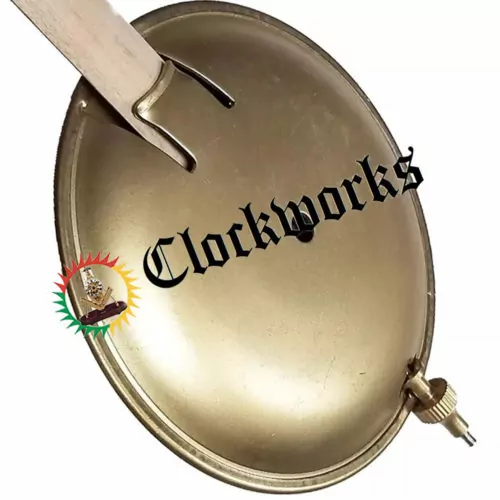

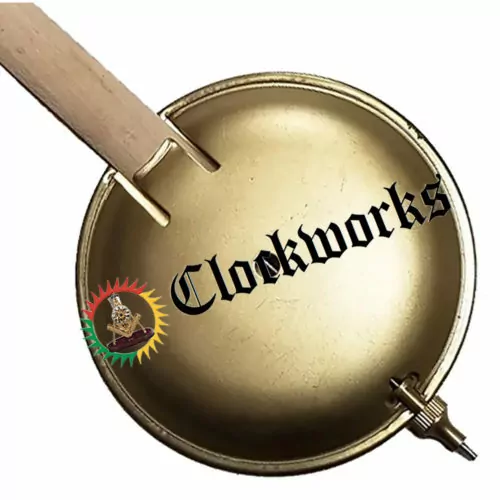
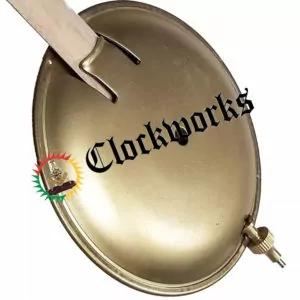

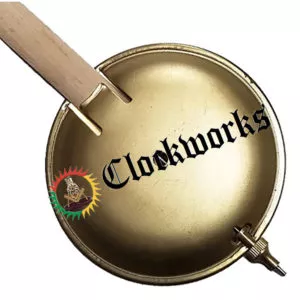
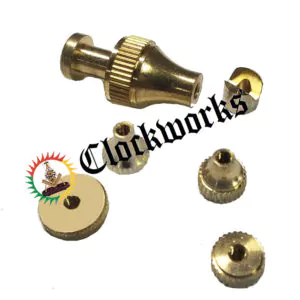
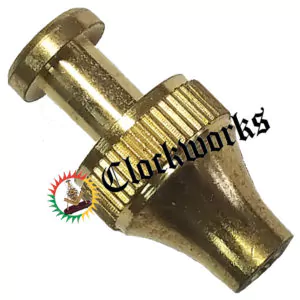
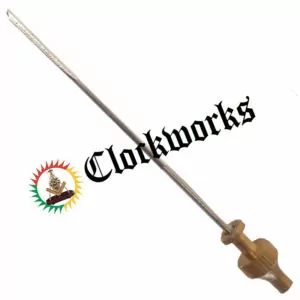
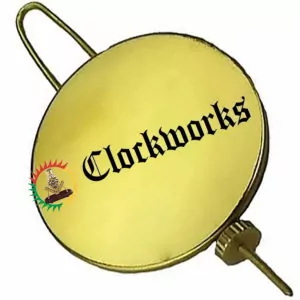











I’m looking for a pendulum for an old Ridgeway grandfather clock. The old pendulum had a brass looking fake coating which somebody tried to polish. This damaged the coating and it looks bad. Also, on the back side it has a big messy blob of lead for weight. How do I order the the right pendulum? Pendulum is 6 1/2″ with a 1″ wood stick. Does the weight come with the pendulum?
What are the numbers off of the back plate of the clock movement itself? If it is hard to get to, usually you can stick a cell phone up behind the movement and get a picture of the numbers. Or through the side access panel if there is one.
James Stoudenmire
40yr Clockmaker
Author of Clockworks.com
It is a Urgos UW 3/1
Please order a pendulum for an Urgos 116cm movement from this link
https://www.clockworks.com/product/uw-urgos-stick-clock-pendulum
or this link
https://www.clockworks.com/product/urgos-uw-lyre-style-clock-pendulum
James Stoudenmire
40yr Clockmaker
Author of Clockworks.com
Thank you. I’m really only needing the bob if possible. Nothing wrong with the stick. I see where the 6 1/2 bob can be ordered, but not sure about the weight that was blobbed on the back of the old bob. https://www.clockworks.com/product/mechanical-clock-pendulum-bob
If they added a blob of weight to the bob, it only means the clock was fast in time and someone added weight to slow it down.
Best to get the pendulum complete because we cut it to proper size so it can keep time with the rating nut / threads
James Stoudenmire
40yr Clockmaker
Author of Clockworks.com
I’m needing a piper grandfather clock pendulum replacement for a clock made in 11-22-77 and it’s German i do believe
What are the numbers off of the back plate of the clock movement itself? If it is hard to get to, usually you can stick a cell phone up behind the movement and get a picture of the numbers. Or through the side access panel if there is one.
James Stoudenmire
30yr Clockmaker
Author of Clockworks.com
I have an Howard Miller Wall Clock model 620-132 Serial Number F0082110495 that I purchased at an auction. It needs a new pendulum kit. Numbers on back of clock are 341-020A. I want to order the correct one for the clock and am unsure what to order. Looking for help.
What is the CM number under that 341-020 number?
James Stoudenmire
30yr Clockmaker
Author of Clockworks.com
31
Please order a pendulum for a Hermle 31cm movement in wood stick style or brass rod style
Wood stick
https://www.clockworks.com/product/wood-stick-pendulum-for-hermle-clocks
Brass rod
https://www.clockworks.com/product/hermle-brass-rod-clock-pendulum
James Stoudenmire
30yr Clockmaker
Author of Clockworks.com
I need a new Pendelum for my mora clock. I dropped it and the metal screw stick broke off. It says PL 61 cm made in Germany but no brand. It’s a long wooden stick with 4 inch bob should I buy the 66cm
How long is the pendulum leader (pendulum hanger) that the pendulum hangs on, from tip to tip as if it was off the clock ?
James Stoudenmire
30yr Clockmaker
Author of Clockworks.com
I am looking for the parts to a Ridgeway Q135 grandfather clock. I need the pendulum, the “spring” , etc.
Hi,
What are the numbers off of the back plate of the clock movement itself? If it is hard to get to, usually you can stick a cell phone up behind the movement and get a picture of the numbers. Or through the side access panel if there is one.
James Stoudenmire
30yr Clockmaker
Author of Clockworks.com
Is the Bob brass?
Not sure, but I would say no just to be sure your not deceived
It is brass tone, but not so sure it is brass or not
James Stoudenmire
30yr Clockmaker
Author of Clockworks.com
Great service, thanks clockworks.
I constructed a Grandmother clock in 1976 from a kit supplied many years ago by the Emperor Clock Company that has ceased business. This clock has a narrow waist section for the pendulum to swing. However, the pendulum bob (4 inches in diameter) keeps hitting the side of the case during its swing. What would be the best solution to this issue, a smaller diameter bob or something else.